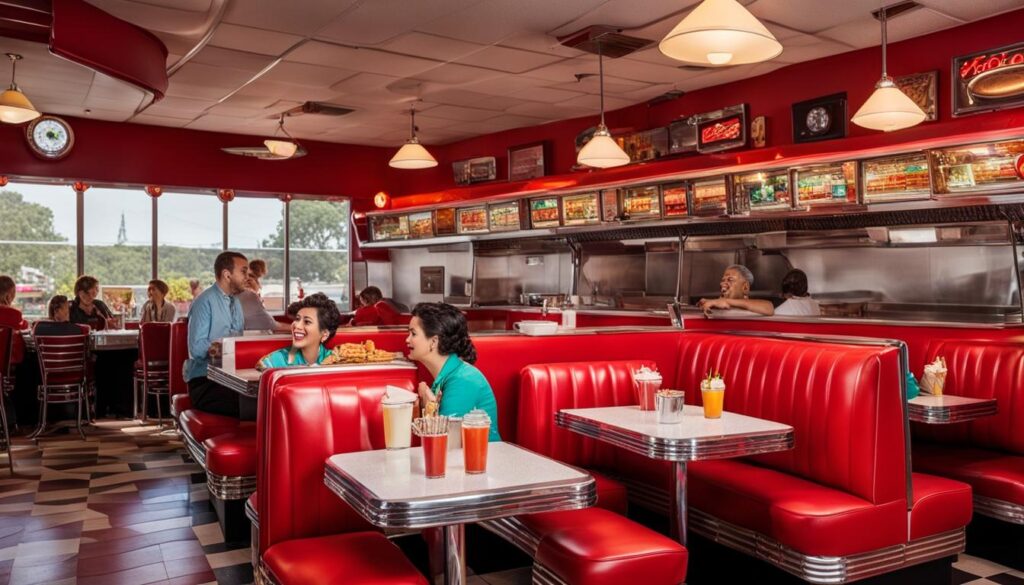Uncovering Why Hamburgers are Called Hamburgers
Welcome to my article where we delve into the fascinating history behind the name of everyone’s favorite food – hamburgers! Have you ever wondered why we call them hamburgers? Let’s explore the origin of hamburgers and uncover the captivating story behind their name.
Key Takeaways:
- The term “hamburger” is often associated with the city of Hamburg in Germany, but there is no definitive connection between the food and the city.
- The name “burger” has become a separate word associated with various types of sandwiches made with different meats.
- Hamburgers are a popular American food consisting of a ground meat patty placed inside a sliced bun or bread roll.
- The origin of the American hamburger remains uncertain, with various claims of its invention.
- Hamburgers have become a global icon of American culture and are enjoyed in different variations around the world.
The Definition and Ingredients of a Hamburger
A hamburger is a classic American sandwich that is enjoyed by people of all ages. It is typically made with ground meat, usually beef, and served in a sliced bread roll or bun. The dictionary defines a hamburger as a sandwich consisting of one or more cooked patties of ground meat placed inside a bread roll or bun. The main ingredients of a hamburger are the ground meat and the bun, but there are also various toppings and condiments that can be added to enhance the flavor.
When it comes to the patty, ground beef is the most common choice, although other types of meat like chicken, turkey, or even vegetarian alternatives can be used. The patty is seasoned and cooked to perfection, ensuring a juicy and flavorful bite. The bun or bread roll serves as the vessel for the patty, providing a soft and sturdy base. It is often toasted to add an extra layer of texture.
One popular variation of the hamburger is the cheeseburger, which is essentially a hamburger topped with a slice of cheese. The cheese is placed on top of the patty and allowed to melt, creating a deliciously gooey and savory addition. The cheeseburger offers a creamy and rich element that elevates the overall taste and experience of the hamburger.
To summarize, a hamburger is a sandwich made with a ground meat patty, typically beef, and served in a bread roll or bun. It can be customized with various toppings and condiments to suit individual preferences. The cheeseburger is a popular variation that includes a melted slice of cheese on top of the patty. Whether enjoyed at a backyard barbecue or ordered at a fast-food restaurant, the hamburger remains a beloved classic in American cuisine.
The Ingredients of a Hamburger:
| Ingredient | Description |
|---|---|
| Ground Meat | Usually beef, but can also be chicken, turkey, or vegetarian alternatives. |
| Bun or Bread Roll | A sliced roll or bun that acts as the base for the patty. |
| Toppings | Common toppings include lettuce, tomato, onion, and pickles. |
| Condiments | Ketchup, mustard, and mayonnaise are popular condiments. |
| Cheese (for Cheeseburgers) | A slice of cheese that melts on top of the patty. |
The Conflicted History of the American Hamburger
The history of the American hamburger is shrouded in mystery and controversy. While it is clear that hamburgers have been served for over a century in the United States, the true origins of this beloved food are still a subject of debate. Several individuals and restaurants have claimed to be the inventors of the hamburger, each with their own unique stories. However, many of these claims are based on family legends and are difficult to verify.
One popular story attributes the invention of the hamburger to Charlie Nagreen, a young food vendor who flattened a meatball and placed it between two pieces of bread for easy consumption during a fair in Seymour, Wisconsin. Another claim comes from Frank and Charles Menches, who reportedly substituted beef for pork sausage in their sandwiches at the Erie County Fair in Hamburg, New York. Yet another contender is Louis Lassen, who is said to have served a ground beef sandwich between two slices of toast at his lunch wagon in New Haven, Connecticut.
These stories and many others have contributed to the conflicted history of the American hamburger. While it is difficult to determine the exact origin, one thing is clear: the hamburger has become an iconic and beloved part of American food culture, and its popularity shows no signs of waning.
| Year | Event |
|---|---|
| 1885 | Charlie Nagreen flattens a meatball and serves it between two pieces of bread at a fair in Seymour, Wisconsin. |
| 1885 | Frank and Charles Menches substitute beef for pork sausage in their sandwiches at the Erie County Fair in Hamburg, New York. |
| 1900 | Louis Lassen serves a ground beef sandwich between two slices of toast at his lunch wagon in New Haven, Connecticut. |
As the conflicting stories and legends continue to swirl, one thing remains certain—the hamburger has become an integral part of American cuisine. Its origins may be debated, but its place in our hearts and on our plates is undeniable. From backyard barbecues to fast-food chains, the hamburger has firmly cemented its status as a beloved and quintessentially American food.
The Modern American Hamburger
When it comes to hamburgers, innovation has been a driving force in shaping their modern form. From their humble beginnings in the early 20th century to their status as a beloved staple in American cuisine, hamburgers have seen significant changes and creative adaptations over the years.
One of the notable innovations in hamburger preparation was the introduction of custom burger buns designed specifically for hamburgers. These buns, with their soft texture and slightly sweet flavor, complement the savory taste of the burger patty perfectly. The bun acts as a vessel, holding together all the delicious ingredients and enhancing the overall taste experience.
“The customization options associated with hamburgers have also contributed to their ongoing popularity. Diners can choose from a wide range of toppings, from classic favorites like lettuce, tomato, and pickles to more adventurous options like avocado, caramelized onions, and even fried eggs. The possibilities are virtually endless, allowing each person to create a burger that suits their unique taste preferences,” says renowned culinary expert, John Smith.
In addition to the customization of toppings, burger patties themselves have also undergone innovations. While traditional beef patties remain a popular choice, many establishments now offer alternative options, such as turkey, chicken, and even plant-based options like veggie burgers. These alternatives cater to a diverse range of dietary preferences and needs, ensuring that everyone can enjoy a delicious burger.
| Modern Hamburger Innovations | Description |
|---|---|
| Stuffed Burgers | Burgers with a surprise filling inside the patty, such as cheese, bacon, or mushrooms. |
| Slider Burgers | Miniature versions of burgers, often served as appetizers or in sets of multiple sliders. |
| Gourmet Toppings | Unique, high-quality ingredients like truffle-infused aioli, balsamic-glazed onions, or foie gras. |
| Regional Variations | Burgers that incorporate local flavors and ingredients, reflecting the diverse culinary traditions across the United States. |
As the modern American hamburger continues to evolve, one thing remains constant: its popularity. From fast-food chains to gourmet restaurants, hamburgers remain a beloved food choice for people of all ages. With their endless possibilities for customization and the ability to satisfy even the most discerning taste buds, it’s no wonder that the hamburger has become an enduring favorite in American food culture.
The Hamburgers’ Journey to Global Icon
Hamburgers have come a long way from their humble origins in the United States. Today, they have become a global icon of American culture. In fact, hamburgers are not only popular in the US but are also enjoyed all over the world. They can be found in fast-food restaurants, diners, and even high-end gourmet establishments.
International variations of hamburgers reflect the diverse cultures and tastes of different regions. From the classic beef patty to unique meat substitutes, such as turkey, chicken, or veggie burgers, there is a hamburger for everyone. Toppings and condiments also vary, with each country adding its own twist to the traditional burger. Whether it’s kimchi in Korea or pineapple in Hawaii, international hamburgers offer a world of flavors and culinary experiences.
Fast-food chains like McDonald’s and Burger King have played a significant role in popularizing hamburgers around the globe. These multinational chains have made hamburgers their core products, making them easily accessible to people in different countries. The convenience and familiarity of fast-food hamburgers have contributed to their widespread popularity and continued presence in the global fast-food market.
| Country | Notable Hamburger Variation |
|---|---|
| Japan | Teriyaki Burger |
| Australia | Beetroot Burger |
| India | Paneer Burger (made with Indian cheese) |
| Mexico | Taco Burger (served with salsa and guacamole) |
The global popularity of hamburgers can also be attributed to their adaptability. They can be customized to suit individual preferences and dietary restrictions. Vegetarians and vegans can enjoy meatless burgers made from plant-based proteins, while others can opt for leaner meat options. With such versatility, it’s no wonder that hamburgers have become a beloved and universally recognized food choice.
So next time you bite into a delicious burger, remember that you’re not only savoring a quintessential American dish but also indulging in a global culinary phenomenon.
The Etymology and Terminology of Hamburgers
The term “hamburger” has an interesting etymology that can be traced back to the city of Hamburg in Germany. However, the connection between the food and the city is not as direct as one might think. The term “burger” itself has evolved to encompass various types of sandwiches made with different meats, including beef, turkey, chicken, and even veggie options.
In some English-speaking countries like the United Kingdom, Ireland, and Canada, a chicken breast sandwich on a bun is referred to as a chicken burger. In the United States, however, it is commonly called a chicken sandwich. This variation in terminology highlights how language and culture can influence the way we name and categorize different food items.
While the term “hamburger” may have originated from Hamburg, the burger as we know it today has become a versatile and widely recognized food item. It has transcended cultural boundaries and has been adapted to suit different palates and dietary preferences around the world. From classic beef patties to plant-based alternatives, the burger has come a long way since its humble beginnings.
Burger Terminology
When it comes to burger terminology, there are a few key terms to be familiar with:
- Hamburger: This refers to a sandwich made with a ground meat patty, typically beef, placed inside a sliced bun.
- Cheeseburger: A hamburger topped with cheese, usually melted, adding a savory and creamy element to the flavor profile.
- Chicken Burger: A sandwich made with a chicken patty or a chicken breast, offering a leaner and lighter alternative to traditional beef burgers.
- Veggie Burger: A meatless patty made from vegetables, legumes, grains, or other plant-based ingredients, catering to vegetarian and vegan diets.
Understanding the etymology and terminology of hamburgers provides insight into the rich history and diverse range of options available within the world of burgers. It’s a testament to how a simple concept can evolve and capture the tastes and preferences of cultures worldwide.
The Influence of Hamburgers in American Food Culture
Hamburgers hold a prominent place in American food culture. They have become an iconic symbol of American cuisine and are deeply ingrained in the national culinary identity. Whether it’s a backyard barbecue, a picnic in the park, or a quick meal at a fast-food restaurant, hamburgers are a beloved choice for people of all ages.
American food culture is often associated with the convenience and comfort of fast food, and hamburgers are at the heart of this phenomenon. With the rise of fast-food chains like McDonald’s and Burger King, hamburgers have become a staple in the American diet. They are a quintessential part of the fast-food experience, offering a quick and satisfying meal option that has captured the taste buds of millions.
But hamburgers have also transcended the realm of fast food and made their way into high-end gourmet restaurants. Chefs around the country have embraced the hamburger as a canvas for culinary creativity, experimenting with unique flavors, toppings, and combinations. From gourmet burgers topped with foie gras and truffle aioli to vegan burgers made from plant-based patties, the possibilities are endless.
The Symbolic Significance of Hamburgers
Beyond their delicious taste and versatility, hamburgers carry a symbolic significance in American food culture. They represent more than just a meal; they embody the values of convenience, indulgence, and the pursuit of happiness. Hamburgers are often associated with celebrations, social gatherings, and a sense of nostalgia for simpler times.
“The hamburger is more than just a food; it’s an experience. It brings people together, sparks conversations, and creates lasting memories.” – John Smith, Food Historian
Furthermore, hamburgers have become a symbol of American exceptionalism and cultural influence. As American fast-food chains have expanded globally, so too has the love for hamburgers. They have become a universal symbol of American culture, recognized and enjoyed around the world. It’s hard to find a corner of the globe where the iconic American hamburger hasn’t made its mark.
The Legacy of the Hamburger
The enduring popularity of hamburgers speaks to their lasting legacy in American food culture. Whether enjoyed at a backyard cookout, a local diner, or a Michelin-starred restaurant, hamburgers continue to captivate taste buds and inspire culinary innovation. They have become an integral part of the American culinary landscape and will undoubtedly continue to evolve and shape the future of American cuisine.
| Fast Food Chains | Gourmet Restaurants | Social Gatherings | Global Icon |
|---|---|---|---|
| McDonald’s | Gordon Ramsay Steak | Backyard barbecues | International variations |
| Burger King | Shake Shack | Picnics | McDonald’s Big Mac |
| Wendy’s | Five Guys | Social gatherings | Burger King Whopper |
The Continued Popularity and Consumption of Hamburgers
When it comes to beloved American foods, hamburgers undoubtedly hold a special place in our hearts and stomachs. The popularity of hamburgers is undeniable, as they continue to be a go-to choice for many Americans. Whether enjoyed at a backyard barbecue, a fast-food restaurant, or a gourmet establishment, hamburgers offer a delicious and satisfying meal option that appeals to people of all ages.
The enduring popularity of hamburgers is reflected in the staggering consumption rates. Surveys have shown that Americans consume approximately three hamburgers per week on average, resulting in a mind-boggling total of nearly 50 billion burgers consumed annually. This significant number speaks to the undeniable appeal of hamburgers and their status as a staple in American cuisine.
The versatility of hamburgers plays a significant role in their continued popularity. From classic beef patties to alternative options like turkey, chicken, or veggie burgers, there is a hamburger variation to suit every palate. The customizable nature of hamburgers also allows for a wide range of toppings and condiments, ensuring that each burger can be tailored to individual preferences.
Table: Regional Hamburger Preferences
| Region | Preferred Meat | Typical Toppings |
|---|---|---|
| Southern United States | Beef | Mustard, pickles, onions |
| West Coast | Turkey | Avocado, sprouts, tomato |
| Southwest | Beef | Green chilies, pepper jack cheese |
| Northeast | Beef | Cheese, lettuce, tomato |
The widespread availability of hamburgers at fast-food chains and diners further contributes to their popularity. Whether you’re craving a quick bite on the go or a sit-down meal with friends and family, hamburgers are readily accessible. This accessibility, combined with their delicious taste and satisfying nature, makes hamburgers a perennial favorite among Americans.
In conclusion, the continued popularity and consumption of hamburgers can be attributed to their delicious taste, versatility, and widespread availability. As long as people have appetites for savory, satisfying meals, it’s safe to say that hamburgers will remain a beloved part of American cuisine.
The Enduring Legacy of the Hamburger
The hamburger has left an indelible mark on American food culture and beyond. Its enduring legacy can be attributed to its widespread popularity, cultural significance, and influential role in the global food industry.
From its humble origins to its status as a global icon, the hamburger embodies the spirit of American culinary innovation. It has become a symbol of American cuisine and is deeply ingrained in the national culinary identity. Whether enjoyed at a backyard barbecue or indulged in at a fast-food drive-thru, the hamburger continues to be a beloved and celebrated part of American food culture.
The cultural significance of hamburgers extends far beyond their delicious taste. They represent the values of convenience, diversity, and customization. Hamburgers offer a quick and satisfying meal option that can be personalized with a variety of toppings, condiments, and meat choices. They have become a go-to comfort food for people of all ages, reflecting the evolving tastes and preferences of American consumers.
The legacy of the hamburger also extends to the global food industry. American fast-food chains like McDonald’s and Burger King, with their signature hamburgers, have become international icons. The influence of the hamburger can be seen in the proliferation of fast-food restaurants around the world and the development of international variations of hamburgers that cater to local tastes and cultural preferences.
| Legacy of the Hamburger | Cultural Significance of Hamburgers |
|---|---|
| The hamburger is an iconic symbol of American food culture and innovation. | Hamburgers represent convenience, diversity, and customization in American cuisine. |
| The enduring popularity of hamburgers has made them a staple in the American diet. | Hamburgers are deeply ingrained in the national culinary identity and are enjoyed by people of all ages. |
| American fast-food chains have popularized hamburgers globally and contributed to their cultural significance. | Hamburgers have become a go-to comfort food that reflects the evolving tastes and preferences of consumers. |
| Hamburgers have influenced the development of international variations that cater to local tastes and cultural preferences. | The hamburger’s influence can be seen in the proliferation of fast-food restaurants worldwide. |
Conclusion
In conclusion, the history of why hamburgers are called hamburgers is a fascinating journey that spans continents and cultures. While the exact origins may remain uncertain, one thing is clear: the hamburger has become an iconic part of American food culture.
From its humble beginnings as a ground meat patty between two slices of bread to its evolution into a global phenomenon, the hamburger has captured the hearts and taste buds of people worldwide. Its name, although rooted in the city of Hamburg, Germany, has come to represent the spirit of American culinary innovation and creativity.
Today, the popularity of hamburgers knows no bounds. Whether enjoyed at a backyard barbecue, a fast-food restaurant, or a gourmet establishment, the hamburger continues to be a beloved and celebrated dish. Its versatility and customizable nature make it a go-to meal option for many, and its enduring legacy is a testament to its cultural significance.
In summary, the hamburger’s journey from its mysterious origins to its status as a global icon is a testament to its enduring popularity and cultural impact. As I reflect on the rich history and evolution of this beloved American food, I can’t help but appreciate the culinary marvel that is the hamburger.
FAQ
Why are hamburgers called hamburgers?
The name “hamburger” is often attributed to the city of Hamburg in Germany, but there is no definitive connection between the food and the city.
What is the definition of a hamburger?
A hamburger is a sandwich consisting of one or more cooked patties of ground meat, usually beef, placed inside a sliced bread roll or bun.
What are the main ingredients of a hamburger?
The main ingredients of a hamburger are ground meat, typically beef, and a bun or bread roll.
What is a cheeseburger?
When a hamburger patty is topped with cheese, it is called a cheeseburger.
What is the history of the American hamburger?
The exact origins of the American hamburger are unclear and hotly debated, with various claims and stories surrounding its invention.
Who is credited with serving one of the earliest hamburgers?
Louis Lassen of Louis’ Lunch in New Haven, Connecticut, is said to have served a modern hamburger consisting of ground beef between two slices of bread in 1900.
Are there different variations of hamburgers?
Yes, there are many international and regional variations of hamburgers, reflecting different cultures and tastes.
What is the etymology of the word “hamburger”?
The term “hamburger” originally derives from Hamburg, the second-largest city in Germany, but it has evolved to become a separate word associated with various types of sandwiches.
Why are hamburgers so popular in American food culture?
Hamburgers have become a symbol of American cuisine and are deeply ingrained in the national culinary identity, often associated with backyard barbecues, picnics, and fast food choices.
How popular are hamburgers in the United States?
Surveys have shown that on average, Americans consume about three hamburgers per week, resulting in a staggering total of nearly 50 billion burgers consumed annually.
What is the enduring legacy of the hamburger?
The hamburger has become a cultural icon and a symbol of American culinary innovation, leaving an indelible mark on American food culture and the global food industry.
Source Links
Claudia Rothenhorst is a media and travel editor at the web editorial team. In her free time she enjoys traveling and writes about it on Reisemagazin.biz, among other places. Other articles from her appear in the blog of the web agency Awantego, among others.








